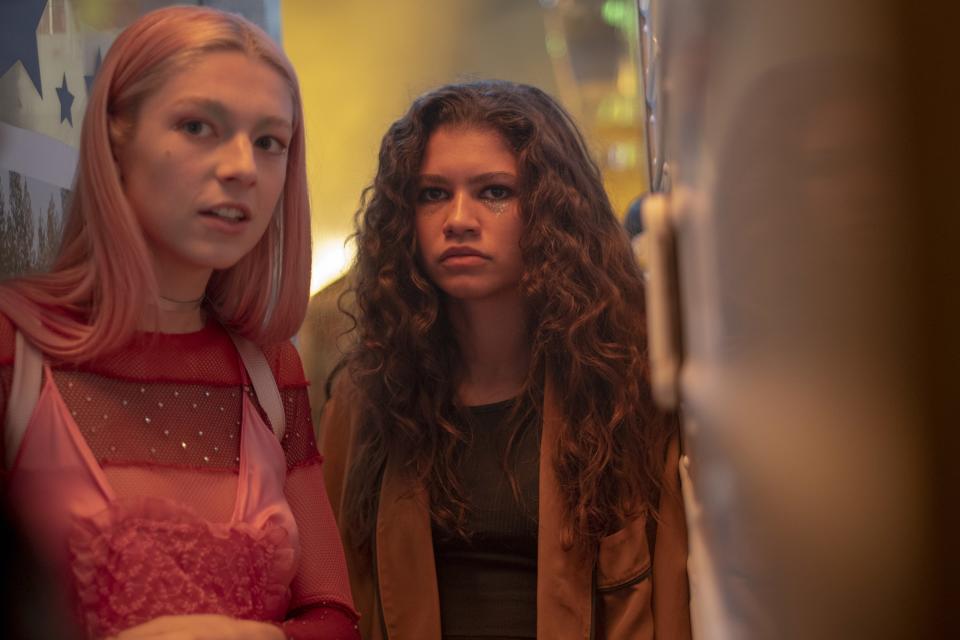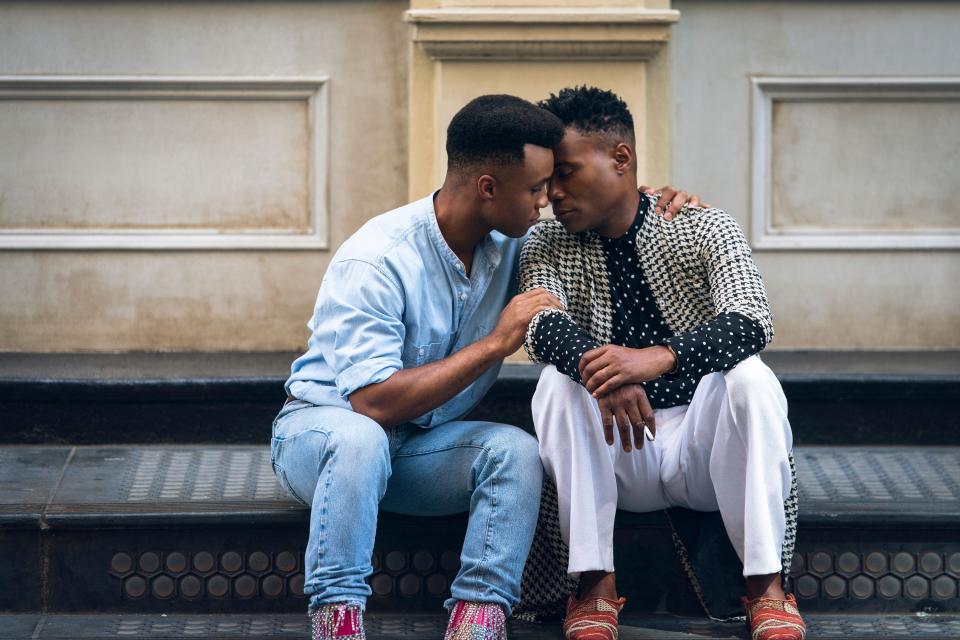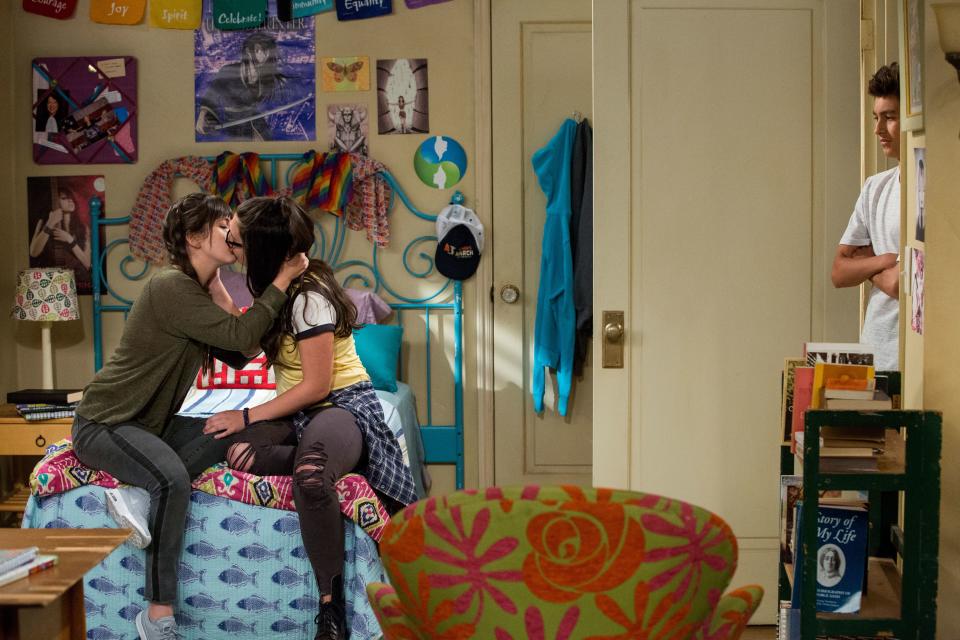The Best Queer Love Scenes of 2019
The 2010s brought us some truly spectacular, nuanced portrayals of queer love onscreen: Pariah (2011), Moonlight (2016), A Fantastic Woman (2017), Black Mirror’s iconic "San Junipero" episode (2016), and so many others. We've come a long way since Marissa Cooper’s brief fling with Alex Kelly on The O.C. 16 years ago — can you believe it?
Though an improvement from previous years, LGBTQ+ characters accounted for just 10.2 percent of regular characters that appeared on broadcast scripted primetime programming this past season of TV, according to GLAAD's 2019-20 TV report. Over on the big screen, GLAAD's 2019 Studio Responsibility Index found that of the 110 releases from major studios in 2018, 20 (18.2 percent) included LGBTQ+ characters.
While overall LGBTQ representation increased during 2018, the racial diversity of LGBTQ+ characters dropped, trans characters remained completely absent, and more than half of all LGBTQ+ characters received under three minutes of screen time. And when sex between queer folks does occur, it often takes place off-screen. What’s more, the queer love and sex we do get onscreen tend to be between white, cis, non-disabled people.
Thankfully, the 2010s went out on a high note, offering some of the most authentic and complex portrayals of queer love possibly ever. Film and TV had a ton of firsts when it came to romance and sex involving LGBTQ+ people. And so, with one month left of the year, let’s celebrate some wins for queer love onscreen during 2019.
It’s worth noting that in past years, it’s been a challenge to find ten meaningful moments of queer love in pop culture. This year, the challenge was narrowing it down to just ten.
Euphoria: Season 1; Episode 8 — “And Salt the Earth Behind You”

In 2019, the world has gone to sh*t...but at least it’s getting queerer. Young people are less concerned with binaries than ever before, and Euphoria reflects this better than any show to date. There’s a lot to love about this HBO series, but at its heart is a good old love story between the teenage protagonist struggling with addiction, Rue (Zendaya), and her new friend, Jules (Hunter Schafer), a trans teen girl who’s new to town.
Adorable and complex, their love is also somewhat unprecedented onscreen. Though trans representation is slowly, slowly (emphasis on slowly) improving, love stories between trans women and cis women — or between trans men and cis men, for that matter — are few and far between. (Until now, Sense8 might be the most well known.)
Episode four brings us one of the year’s dreamiest, most theatrical onscreen smooches, as the two best friends share their first kiss, but that’s not the moment. That moment comes in the season finale when Rue suggests the two of them leave town and proceeds to confidently, and finally, kiss Jules without first asking, which is what Jules asked and hoped that she would do. It’s everything we’d been waiting for all season. Unfortunately, then things kind of go downhill.
Vida: Season 2; Episode 10
Mexican-American showrunner Tanya Saracho’s Chicanx drama has given us some of the most memorable queer Latinx sex scenes of the Trump presidency. This should come as no surprise — after all, the show’s writers room is 100% Latinx, almost entirely women, and more than a third queer. (Saracho herself is a queer Latina.)
Vida tells the story of two Mexican-American sisters from Los Angeles who return home to a gentrifying Boyle Heights to take over a family bar following the sudden death of their mother, Vidalia. They soon learn that their mom was hiding the fact that she was married to a woman (non-binary Chicanx actor Ser Anzoategui), and the bar she owned and ran their entire life had become a safe space for East L.A.’s Chicanx lesbians. The revelation is a particular shock to the elder of the two sisters, Emma (Mishel Prada), who as a teen was sent away by Vida for being queer.
Emma, who hasn’t recovered from this experience, is guarded and uses sex as a power move. In one of the first season’s most talked-about moments, Emma has sex with a non-binary hookup she meets online. She also begins a fling with her childhood crush, Cruz (Maria-Elena Laas). A season two episode starts with Emma and Cruz having steamy sex (and putting a condom on a vibrator, which is the correct and safest way to use a vibrator).
But it isn’t until the season two finale that Emma finally gets sex and romance. After weeks of tension between Emma and the dreamy Nico (Roberta Colindrez), the two finally do the deed. Their bar bathroom hookup caused me a great deal of anxiety, but seeing two queer Latinas hot and heavy on screen is nonetheless a cause to celebrate.
Pose: Season 2; Episode 10 — “In My Heels”
In season one of Pose, Angel (Indya Moore) — the young trans woman, sex worker, and beloved daughter of the House of Evangelista — finds herself involved with a married, cisgender, heterosexual guy (Evan Peters). He’s a bit of a drag, and thankfully he’s out of the picture in season two.
Instead, Angel embarks on a professional modeling career and finds love in an unexpected place: with her adorable, street-wise Evangelista brother, Lil Papi, who soon takes on the role of Angel’s doting boyfriend and manager. In a time in which at least 19 Black trans women have already been killed by violent means in the U.S. this year, Papi’s radical love for Angel is a powerful example of what a cis man loving and caring for a trans woman can look like. Their surprise co-proposal in the season two finale, in which Angel gets down on one knee and Papi follows suit, has got to be one of the most endearing proposals in TV history.
Portrait of a Lady on Fire
Oh, boy. I still haven’t recovered from French director Céline Sciamma’s lesbian drama. Set in the 1770 French seaside, Portrait tells the story of a young artist, Marianne (Noémie Merlant), commissioned to paint the wedding portrait of a young woman, Héloïse (Adèle Haenel) — but without her knowledge. The two develop a bond as Marianne sets out to observe Héloïse by day to paint her portrait at night.
Things reach a breaking point at a, you guessed it, a fire! The music, the dancing women, the looks. It’s just too much.
Since premiering at Cannes back in May, Portrait has generated something of a cult following online. In 2019, a big-screen love story about two white French ladies shouldn’t be so radical. But alas, it is. Only a queer filmmaker could have created a queer love story this exquisite. (Fun fact: Sciamma is a lesbian and was previously in a relationship with Haenel.) Perhaps more so than any other work of the late 2010s, Portrait shows how far we’ve come since the seven-minute, hetero-male-gaze lesbian-sex extravaganza that was 2013's Blue Is the Warmest Colour. Thank you, Céline Sciamma.
Special: Season 1; Episode 3 — “Free Scones”
One in four people in the U.S. are living with a disability. Meanwhile, just 2.1% of regular characters on primetime TV in the 2018-2019 season had disabilities, according to a report from GLAAD. Of the people with disabilities depicted on screen, far fewer are queer. Special, the semi-autobiographical Netflix series about a gay man with cerebral palsy, is single-handedly upping the ante when it comes to queer and disabled representation on TV.
In the show’s third episode, “Free Scones,” Ryan (played by the series creator Ryan O'Connell) has sex for the first time with a sex worker. No, he doesn’t fall in love. But he does have awkward first-time gay sex. And it’s refreshingly more realistic than what we’re used to between two gay men on screen. It’s also kind of cute. What’s more, the scene normalizes sex with a sex worker. Here’s to more queer, disabled sex and romance in 2020. In particular, it’s high time for TV and movies to show queer disabled people of color in love.
Pose: Season 2; Episode 8 — “Revelations”

TCDPOSE FX021
Michael Parmalee / ©FX / Courtesy Everett CollectionWhen Pose debuted in 2018, it made television history for having the largest cast of openly trans actors in series-regular roles and the largest LGBTQ+ cast for a scripted series. In its second season, the FX drama continued to break barriers, including with one of the most discussed sex scenes of the year.
Toward the start of Pose’s sophomore season, Damon (Ryan Jamaal Swain) and Ricky (Dyllón Burnside) — two young and gay Black men in love — break up. And if you’re like me, you were heartbroken. In a season full of heartache, Ricky later finds out he’s living with HIV. He seeks and finds support from Pray Tell (Billy Porter), with whom he shares an HIV diagnosis as well as an unexpected but obvious attraction. In one of the show’s steamiest scenes so far, Ricky and Pray have sex. The scene, directed by Pose co-creator and executive producer, Steven Canals, was nothing short of momentous. It’s rare enough for TV and film to portray hot sex between two gay men; it’s even rarer for it to be two Black men. And the fact that both men are Black and living with HIV was virtually unheard of.
Booksmart
In Booksmart, the straight protagonist Molly (played by Beanie Feldstein, who herself is in a long-term relationship with a woman) acts as wingperson to her gay best friend, Amy (Kaitlyn Dever), who has yet to kiss a girl since coming out two years prior. When considering that the gay best friend (GBF) trope shows no signs of slowing down, this in itself is a pretty radical plot for a Hollywood movie.
For anyone who isn’t familiar with the plot of Booksmart, it’s simple: best friends and over-achievers Amy and Molly set out to attend their first and final high school party on the eve of graduation, with one of the main goals being that Amy tells her cool skater-girl crush how she feels.
Of course, that doesn’t happen. Just when we think it’s coming, the hopeful young lesbian spots Ryan making out in the pool with Molly’s dude crush. Amy is devastated. Obviously. But her teenage heartbreak quickly leads to the movie’s pinnacle hookup scene, in which Amy encounters her cool-but-kind-of-mean, very hot classmate Hope (Diana Silvers) in the bathroom. Emboldened by rejection, Amy makes a move. The two proceed to make out. And then they do more than make out, a first for Amy and presumably for Hope as well. It’s awkward and it’s far from sexy — but isn’t that how most first hookups go?
Oh, and Delta censored it at one point. Thankfully, the scene has since been restored to all its awkward, young queer glory.
One Day at a Time: Season 3; Episode 7 — “The First Time”

3
Ali Goldstein / ©NetflixLed by its Cuban-American co-showrunner, Gloria Calderón Kellett, the One Day at a Time reboot has fast become one of the most beloved sitcoms. Centering around three generations of the Cuban-American Alvarez family, this touching sitcom has never been one to shy away from some of the biggest issues and themes of today, such as mental health, addiction, PTSD amongst veterans, workplace sexism, consent, homophobia, xenophobia, and even young queer love.
One of the show’s most heartwarming storylines is the relationship between the Alvarez family’s activist teen daughter, Elena (who comes out as a lesbian in season one and is played by Isabella Gomez), and her “Syd-nificant other,” Syd (Sheridan Pierce), who is non-binary and uses they/them pronouns. The feminist nerds meet in season two at the first Feminist Gamers of Echo Park gathering.
In the season three episode, “The First Time” (co-written by queer writer, Michelle Badillo, in her second appearance on this list), the two 17-year-olds decide they are ready to have sex. Frustrated by months of having to sneak in make outs at the notoriously un-private Alvarez house, Elena and Syd rent a hotel room for a night. It’s awkward and dorky (I mean, it’s soundtracked by the X-Files theme song), and after Elena finds out Syd has had sex before, it almost doesn’t happen.
Being the first family sitcom to show a queer teen’s first time is no small feat, but One Day at a Time tackles it with a big heart and plenty of nuance.
Dear White People: Volume 3; Chapter 5
For much of its first two seasons, Kelsey (Nia Jervier), the privileged Trini girl and roommate to one of the show’s more central characters, served largely as comedic relief. Her first big moment comes in the show’s second season, when her roommate — and viewers — are surprised to learn she’s a lesbian, nor was she ever hiding it. “I’ve been out since Queen Janet’s wardrobe malfunction,” she tells Coco.
In season three, Kelsey finally gets her own love story when she locks eyes with Brooke (Courtney Sauls), the nerdy, pushy, know-it-all student journalist who was similarly a minor character in the show’s first two seasons. Brooke puts her thirst for college f*ckbois on hold to pursue a connection with Kelsey. A flirty courtship soon begins, culminating in episode five, in which Kelsey and Brooke get together. Their adorable romance doesn’t last long at all, but the significance of two Black girls romancing onscreen should not be forgotten.
Rocketman
Among its many, many flaws, Bohemian Rhapsody was a very un-queer, very sexless movie about one of history’s queerest, most sex-hungry rockstars. Rocketman, the far superior of the two recent music biopics, is not the be-all and end-all of queer love and sex on the silver screen. The scene still left much to the imagination with the camera panning away just as things start to get really steamy. But with all that being said, it is a move in the right direction.
Though Hollywood is getting more comfortable with the idea of gay love stories on screen, it still hasn’t totally gotten around to the idea of showing two men having sex on screen. Even Call Me By Your Name shied away from explicit scenes with Elio and Oliver. Though only brief, Rocketman’s much-discussed sex scene, in which Elton John (Taron Egerton) has sex for the first time with his soon-to-be manager, John Reid (Richard Madden), made movie history as the first time a major studio release has included onscreen gay male sex. (This excludes Brokeback Mountain and Moonlight, which were released by independent studios or specialty arms of major studios.)
Editor's note: This story has been updated.
Originally Appeared on Teen Vogue

